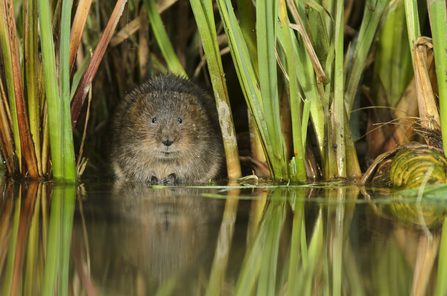
There's still time to save Ratty. Image by Terry Whittaker 2020VISION.

There's still time to save Ratty. Image by Terry Whittaker 2020VISION.
A new report from The Wildlife Trusts, The National Water Vole Database Project Report, identifies continued declines in water vole populations set against heartening increases in areas where conservation efforts have been focused.
Northumberland Wildlife Trust’s Restoring Ratty project worked to bring back Britain’s favourite mammal to the waterways of Kielder, resulted in the release of 2000 water voles between 2016 and 2021.
The national report examines water vole distribution over ten years by analysing the number of 10km grid squares across the country where water voles are present.
Statistics show overall water vole range declining - a 39% decrease in the number of areas occupied by water voles compared to the 2006 baseline.
However, when the data is examined more closely encouraging trends emerge. The Wildlife Trusts’ project also looks at the concentration of water voles and has found that whilst the national picture is one of overall decline, some important local pockets of water vole populations have been increasing, with several new regional key areas identified in recent years.
Katy Barke, Northumberland Wildlife Trust’s Nature Recovery Manager says:
“The data is giving a very clear message. The overall national picture is one of decline due to the destruction of natural habitats and predation by the non-native American mink. However, water vole populations will thrive when the right conditions are created. It’s heartening to see that we can still rescue Ratty if we all plan well and co-ordinate our efforts.
“Water voles are mini ecosystem engineers, rather like beavers, and they contribute greatly to healthy river ecology. Reversing their historic loss needs to be a key focus of our conservation efforts.”
Regionally important areas which have been newly identified, or which have expanded since the last analysis, include areas where conservation work to support the return of water voles has been undertaken.
“Just because voles are present, it doesn’t mean that they are thriving. We still need to ensure that that we provide undisturbed riverbanks, reedbeds and ponds, and remove the non-native American mink that have devastated water vole populations, to allow their numbers to build up once more.”
Water voles look after the UK’s riverbanks, burrowing and eating a huge range of plants species. In doing so, they move seeds around, helping to maintain varied plant cover and creating lush and wild bankside vegetation. They are also a key food source for native species like stoats, predatory fish, and birds of prey.
The Wildlife Trusts are calling for: